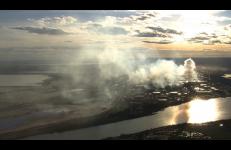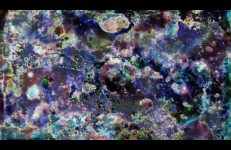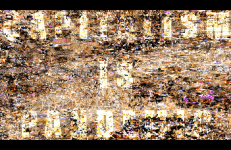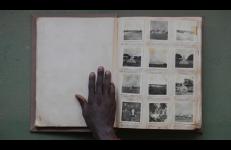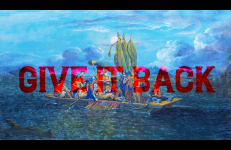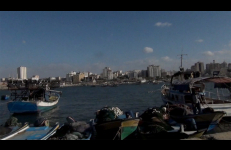Water and oil form the undercurrents of all narrations as they activate profound changes in the planetary ecology. After the oil peak, ever dirtier, remote and deeper layers of fossil resources are being accessed. Aerial recording of the devastated crust in Alberta opens the view into dark lubricant geologies. Climate change, exasperated by projects such as the Canadian tar sands, puts the life of large world populations in danger.
Post-colonialism
The Dresden Codex is a prehispanic book that was kidnapped and was rediscovered in the city of Dresden, Germany. It keeps a presage of a destruction to come.
The supposed existence of a golden kingdom motivated numerous expeditions, and the belief remained in force until the 19th century, although its location moved from Colombia to the Guianas, as the process of conquest and colonization of the South American territory progressed. A journey and a drift from extractive colonialism that is far from over.
The Embassy deals with the codes of representation used by the former Portuguese colonial power over the West African country Guinea-Bissau, and with modes of memory production. It shows a photo album depicting the perspective of the Portuguese colonist, who photographed with documentary diligence landscapes, people, architecture and monuments in Guinea-Bissau in the 1940s and 1950s.
Efforts to “decolonize” institutions are embodied in ritual acts of acknowledging Indigenous presence and claims to territory. However, without continuous commitment to serve as accomplices to Indigenous people, institutional gestures of acknowledgement risk reconciling “settler guilt and complicity” and rescuing “settler futurity” How can we escape this entrapment and allow acknowledgement to retain its potential to unsettle? What must we do to begin to undertake a process of endless acknowledgement?
In this interview, African American filmmaker and DJ Ephraim Asili (b. 1979) discusses his upbringing, education, and creative process. Born and raised around the city limit of Philadelphia, Asili’s childhood and adolescence were imbued with hip hop music, Hollywood movies and television.
Fences Make Senses re-stages and interrogates international barriers and borders using the bodies of non-refugees. Through a series of rehearsals, Barber aims to have privileged bodies experience the themes, situations, and ideas that refugees frequently face. This video was produced in response to the great number of documentaries the artist witnessed that interviewed the unfortunate in their impoverished conditions. Kept in limbo and squalor for years, these refugees are casually disliked by their "host" country.
Fluid Frontiers is the fifth and final film in the series entitled The Diaspora Suite, exploring Asili’s personal relationship to the African Diaspora. Shot along the Detroit River, Fluid Frontiers explores the relationship between concepts of resistance and liberation, exemplified by the Underground Railroad, Broadside Press, and artworks of local Detroit Artists.
Over 6,000 gold prospectors invade the reserve of the Nambiquara of Sararé, and loggers raid the mahogany-rich forests, which are threatened by extinction. Pressure on the World Bank (with whom the government of Mato Grosso is negotiating a loan) could end prospecting, but the pillage of the forest continues.
In Portuguese with English subtitles.
Directed by Vincent Carelli, Maurizio Longobardi, and Virginia Valadão; edited by Tutu Nunes.
Over 6,000 gold prospectors invade the reserve of the Nambiquara of Sararé, and loggers raid the mahogany-rich forests, which are threatened by extinction. Pressure on the World Bank (with whom the government of Mato Grosso is negotiating a loan) could end prospecting, but the pillage of the forest continues.
In Portuguese with English subtitles.
Directed by Vincent Carelli, Maurizio Longobardi, and Virginia Valadão; edited by Tutu Nunes.
Over 6,000 gold prospectors invade the reserve of the Nambiquara of Sararé, and loggers raid the mahogany-rich forests, which are threatened by extinction. Pressure on the World Bank (with whom the government of Mato Grosso is negotiating a loan) could end prospecting, but the pillage of the forest continues.
In Portuguese with English subtitles.
Directed by Vincent Carelli, Maurizio Longobardi, and Virginia Valadão; edited by Tutu Nunes.
In this 2014 interview, South African artist Kendell Geers (b. 1968) discusses the function of magic, myth, and memory in his work. Beginning at childhood, Geers charts the path he has taken in his understanding of his own biography as a site of resistance. This interest in the use of personal biography culminated in 1993 with his decision to change his date of birth to May 1968 as a way to reference both the May 1968 student protests, and the fact that 1993 was the first year that South Africa had participated in the Venice Biennale since 1968.
"i am very grateful that my 鬼鎮 (Ghosttown) series has shown internationally over the last couple years and is recognized by viewers, reviewers, critics, and curators as doing decolonizing work as a feminist project that queers and glitches the Western genre. 鬼鎮 (Ghosttown) questions the quintessentially American Western in the forms of experimental films and games that are made from glitches and noise, pushing boundaries of legibility and tipping over threshold states of stability.
Chief Pedro Mãmãindê (who directed the proceedings and the shoot itself) describes the necessity of strengthening the girls of his village by secluding them after their first menses. After several months, the village throws a party, with singing, feasting, and the ritual abduction of the girl by an allied village. When the Nambiquara of Mato Grosso see videotape of themselves performing this ritual, the excess of Western clothing makes them uncomfortable. The ritual is then re-enacted with traditional body painting and adornment.
Chief Pedro Mãmãindê (who directed the proceedings and the shoot itself) describes the necessity of strengthening the girls of his village by secluding them after their first menses. After several months, the village throws a party, with singing, feasting, and the ritual abduction of the girl by an allied village. When the Nambiquara of Mato Grosso see videotape of themselves performing this ritual, the excess of Western clothing makes them uncomfortable. The ritual is then re-enacted with traditional body painting and adornment.
Give it Back: Stage Theory’s point of departure is the détournement of Panorama of the Monumental Grandeur of the Mississippi Valley (1850), a 9 foot tall, 348 foot long proto-cinematic moving panorama commissioned by and based on the contemporaneous notes and drawings of 19th century amateur archaeologist and glorified grave robber Montroville W. Dickeson — who spent 12 years of his life traveling the Mississippi River and digging up Indigenous burial mounds.
Louis Henderson’s work focuses on anti-colonialism and criticizing the neocolonialisation of cyberspace. Born in England in 1983, he graduated from London College of Communication and Le Fresnoy - Studio national des arts contemporains. He recently finished a post-diplôme at the European School of Visual Arts.
A search for a non-existent image, a desire to create an image where there is none,“ leads to Rea Tajiri’s composition on recorded history and non-recorded memory. Framed by the haunting facts of the post-Pearl Harbor Japanese internment camps (which dislocated 120,000 Japanese Americans during World War II), Tajiri creates a version of her family’s story through interviews and historical detail, remembering a time that many people would rather forget.
Home Movies Gaza introduces us to the Gaza Strip as a mircrocosm for the failure of civilization. In an attempt to describe the everyday of a place that struggles for the most basic of human rights, this video claims a perspective from within the domestic spaces of a territory that is complicated, derelict, and altogether impossible to separate from its political identity.
"... Basma Alsharif’s Home Movies Gaza, a film that captures the impossibly politicized domestic sphere of the Gaza Strip, under the constant hum and buzz of overhead drones."
Hostage: The Bachar Tapes (English Version) is an experimental documentary about "The Western Hostage Crisis." The crisis refers to the abduction and detention of Westerners like Terry Anderson, and Terry Waite in Lebanon in the 80s and early 90s by "Islamic militants." This episode directly and indirectly consumed Lebanese, U.S., French, and British political and public life, and precipitated a number of high-profile political scandals like the Iran-Contra affair in the U.S.
Hostage: The Bachar Tapes (English Version) is an experimental documentary about "The Western Hostage Crisis." The crisis refers to the abduction and detention of Westerners like Terry Anderson, and Terry Waite in Lebanon in the 80s and early 90s by "Islamic militants." This episode directly and indirectly consumed Lebanese, U.S., French, and British political and public life, and precipitated a number of high-profile political scandals like the Iran-Contra affair in the U.S.
Adapted from psychologist A.R. Luria’s research in the Islamic outskirts of the Soviet Union in the 1930s, How to Fix the World brings to life Luria's conversations with Central Asian farmers learning how to read and write under the unfamiliar principles of Socialism.
Colorful digital animations based on Max Penson's photographs of collective farmers play against a backdrop of landscape images shot in Uzbekistan in 2004.
Adam Khalil and Zack Khalil’s debut film re-imagines an Anishinaabe story, the Seven Fires Prophecy, which both predates and predicts first contact with Europeans. A kaleidoscopic experience blending documentary, narrative, and experimental forms, INAATE/SE/ explores how the prophecy resonates through the generations in their Indigenous community on the Michigan/Canadian border.
Adam Khalil and Zack Khalil’s debut film re-imagines an Anishinaabe story, the Seven Fires Prophecy, which both predates and predicts first contact with Europeans. A kaleidoscopic experience blending documentary, narrative, and experimental forms, INAATE/SE/ explores how the prophecy resonates through the generations in their Indigenous community on the Michigan/Canadian border.
Using footage from mainstream British and Hollywood films, and excerpts from a poem by Shani Mootoo, this video explores the impact of cultural imperialism and the erasure of language—residual tools of oppression on members of post-colonial societies.
This title is also available on The New McLennium.




